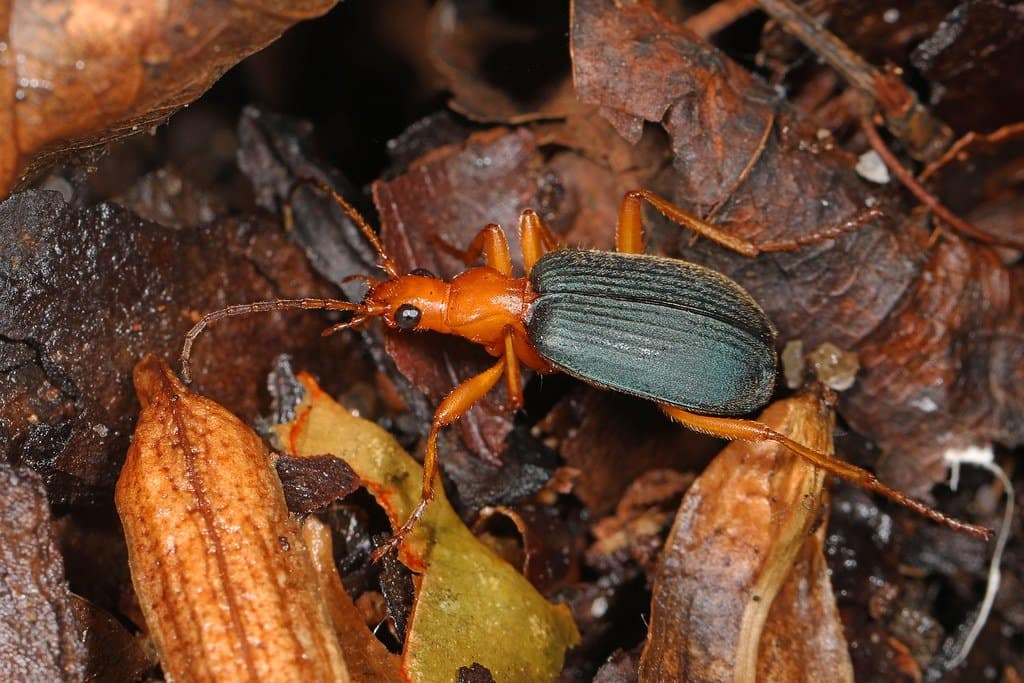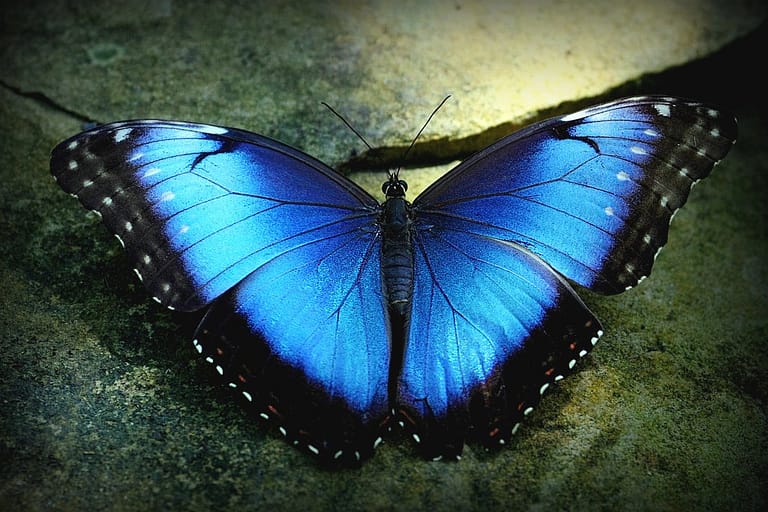Insects, often overlooked and underappreciated, are an integral part of our natural world. They come in an astonishing variety of forms and sizes, each adapted to survive in unique ways in their respective environments.
Bombardier Beetle

The Bombardier Beetle is a marvel of chemical warfare in the insect world. When threatened, it mixes hydroquinone and hydrogen peroxide stored in separate chambers in its abdomen to create a boiling, noxious spray, which is ejected with a loud popping sound. This defensive mechanism is highly effective against predators like birds and frogs. The beetle can aim this spray with remarkable precision, ensuring maximum impact. This unique chemical defense system has intrigued scientists for years, leading to studies in the fields of chemistry and physics. Beyond their defense mechanism, Bombardier Beetles are generally small to medium-sized and found in various habitats worldwide, from forests to grasslands, exemplifying an incredible adaptation for survival.
Atlas Moth

The Atlas Moth, one of the largest moths in the world, is a wonder of nature with a wingspan reaching up to 11 inches. Native to Southeast Asia, these moths are known for their striking wing patterns, which include snake-like designs on the wingtips, believed to be a defense mechanism against predators. The females are generally larger and have more vibrant colors compared to males. Uniquely, Atlas Moths do not have fully developed mouths and, therefore, do not eat during their adult life, which typically lasts for about one to two weeks. Their lifecycle from egg to caterpillar, pupa, and finally to adult moth is a fascinating transformation, showcasing the diversity and beauty of the insect world.
Praying Mantis

The Praying Mantis, named for its prominent front legs folded as if in prayer, is a formidable predator in the insect kingdom. These insects are masters of camouflage, blending seamlessly into their surroundings to ambush unsuspecting prey. Their elongated bodies, triangular heads with bulging eyes, and flexible necks give them a distinctive appearance. They possess excellent vision, allowing them to track and capture prey with precision. The praying mantis is also known for its peculiar mating behavior, where the female sometimes eats the male after or during mating, a phenomenon known as sexual cannibalism. This behavior, along with their predatory skills and unique appearance, makes the praying mantis a subject of fascination and study in entomology.
Glowworm

Glowworms are not worms but are actually the larval form of a beetle or a fly. They are best known for their bio-luminescent ability, where they produce a soft, enchanting light from their bodies. This light, usually blue or green, is used to attract prey, making them a natural lure in the dark environments they inhabit, such as caves or forest undergrowth. The light is the result of a chemical reaction involving luciferin, a light-emitting compound, in the presence of oxygen. Glowworms are found in various parts of the world, including New Zealand and Australia, where they are a popular tourist attraction, creating starry-like illuminations on cave ceilings and walls, showcasing a captivating aspect of the natural world.
Peacock Spider

The Peacock Spider, belonging to the genus Maratus, is a small spider known for its extraordinarily colorful and vibrant courtship displays. Native to Australia, these spiders are tiny, with males usually measuring less than 5 mm. The males are famous for their iridescent, peacock-like tail flaps, which they extend and raise during courtship rituals to attract females. This display is accompanied by a dance involving leg waving and body vibrations. The vivid colors and patterns on their abdomens vary significantly across different species in the genus. Their elaborate mating dance, combined with their striking appearance, makes the Peacock Spider a fascinating subject for photographers and scientists, illustrating the incredible diversity and complexity of mating behaviors in the animal kingdom.
Stick Insect

Stick Insects, also known as walking sticks, are renowned for their remarkable camouflage capabilities. Resembling twigs or branches, they are almost undetectable in their natural habitats, which primarily include forests and grasslands. This mimicry is not just in appearance but extends to their behavior, where they sway like branches in the wind. Stick insects can vary in size from a few centimeters to over 30 centimeters in some species. Some species can regenerate lost limbs, and many exhibit parthenogenesis, where females reproduce without mating. Their ability to avoid predation through mimicry and their diverse reproductive strategies make them a subject of interest in evolutionary biology and ecology, highlighting the adaptability and survival tactics in the insect world.
Death’s-head Hawkmoth

The Death’s-head Hawkmoth is a species famous for its ominous skull-shaped pattern on its thorax. This large moth, found across Europe and parts of Africa and Asia, has fascinated people for centuries, often associated with superstitions and folklore. Besides its distinctive appearance, it’s known for its unusual behavior of raiding bee hives for honey. What’s remarkable is its ability to produce a squeaking sound, which is thought to help in calming the bees while it feeds. The moth’s name and appearance have led to its frequent appearance in art and literature, symbolizing death and the supernatural.
Leafcutter Ant

Leafcutter Ants are remarkable for their advanced social structures and agricultural practices. Found primarily in the Americas, these ants cut leaves and carry them back to their nests, not to eat them, but to use them as a substrate to cultivate fungus, which is their primary food source. These ants exhibit a high degree of cooperation and division of labor within their colonies, which can number in the millions. Their ability to cultivate crops places them among the few species, including humans, that engage in agriculture. This behavior has significant ecological impacts, as they are major herbivores in the regions they inhabit.
Dragonfly

Dragonflies are known for their exceptional flying abilities and are among the fastest insects. They are capable of reaching speeds of up to 30 mph, can hover, fly backward, and make rapid turns, making them agile hunters. Their two pairs of strong, transparent wings operate independently, allowing for precise maneuvering. Dragonflies also have large, multifaceted eyes that give them almost 360-degree vision, crucial for detecting movement of prey and avoiding predators. These insects are found near freshwater habitats across the world and play a vital role as predators, helping control populations of mosquitoes and other insects. The dragonfly’s life cycle, which includes an aquatic larval stage, adds to its ecological importance. Dragonflies are also culturally significant in many societies, often symbolizing change and self-realization.
Butterfly (Morpho species)

Morpho butterflies, primarily found in Central and South American rainforests, are celebrated for their stunning iridescent blue wings. The vibrant blue is not due to pigment but is caused by the microscopic structure of the scales on their wings, which reflect and refract light. This phenomenon, known as structural coloration, makes their wings appear differently depending on the viewing angle. Morpho butterflies’ wingspan can reach up to 20 centimeters, making them one of the largest butterflies. They play a critical role in the ecosystem as pollinators and as a food source for other animals. The beauty and unique properties of Morpho butterflies have not only made them a subject of extensive scientific research but also a symbol of beauty and transformation in various cultures.
Fleas

Fleas are small, wingless insects, notorious as parasites that feed on the blood of mammals and birds. One of their most remarkable features is their jumping ability; they can leap distances over 100 times their body length, making them some of the best jumpers in the animal kingdom, relative to body size. This impressive feat is achieved through the storage and release of energy in specialized elastic structures in their bodies. Fleas are also known for their role in transmitting diseases, most notably as vectors for the bubonic plague. Their life cycle includes four stages – egg, larva, pupa, and adult – and they can be incredibly hardy, surviving in challenging environments. The flea’s resilience and jumping prowess make it a subject of interest in both biological study and pest control.
Goliath Beetle

Goliath Beetles, named after the biblical giant, are among the largest and heaviest insects on Earth. Found in Africa’s tropical forests, these beetles can weigh up to 100 grams in their larval stage and grow up to 11 centimeters in length as adults. Their size is a result of the high protein diet they consume during their larval stage. Goliath Beetles are known for their striking appearance, with colorful, patterned bodies, and strong, formidable jaws. Despite their size and formidable appearance, they feed primarily on tree sap and fruit. The life cycle of the Goliath Beetle, from egg to larva, pupa, and adult, is a testament to the diversity and adaptability of insect life, making them a point of fascination for entomologists and collectors.
Cicada

Cicadas are renowned for their loud, distinctive calls and the periodic emergence of some species. Among these, periodical cicadas are especially famous, emerging every 13 or 17 years in massive numbers. During an emergence, which is among the longest life cycles of any insect, they mate and lay eggs before dying, creating a significant ecological event impacting local ecosystems. Cicadas are found worldwide and are known for their large size and membranous wings. Their songs, produced by males using specialized structures called tymbals, are a defining sound of summer in many regions. The cicada’s lifecycle, particularly of periodical species, their loud calls, and their impact on ecosystems, make them a subject of both scientific study and cultural significance.
Vampire Moth

Vampire Moths, primarily belonging to the genus Calyptra, are unique in the moth world for their blood-feeding habit. Unlike their nectar-feeding relatives, these moths are equipped with a specialized proboscis designed to penetrate the skin of animals, including humans, to consume blood. This remarkable adaptation, more prevalent in female moths, aids in egg production by utilizing the rich nutrients found in blood. Originally believed to be fruit feeders, Vampire Moths are primarily found across Europe and Asia.This unusual dietary choice, a rare example of hematophagy (blood-feeding) in insects, makes Vampire Moths a particularly intriguing subject for biological and evolutionary research.

